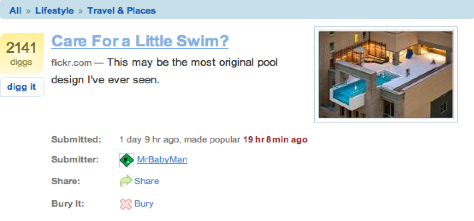The Web's Link-Driven Attention Economy
Photographer Lane Hartwell, by making all of her Flickr photos private to prevent uncredited use, and by forcing the take down of a parody video containing one of her photos, has shined a spotlight on the question of content owner’s rights on the web.
Mathew Ingram and Mike Arrington argue that Lane is on the wrong side of copyright law with the video take down, which she may be, but the reality is that the web has developed a de facto law of it’s own when it comes to fair use.
In the post-YouTube, post-BitTorrent era on the web, there is no content that can’t be easily reproduced by anyone, anywhere, for free. But that doesn’t mean there isn’t a currency for content on the web, which most content producers accept in exchange for a fair-use excerpt or even reproduction of the entire work.
The link.
The entire content economy on the web is based on the link, because the one resource that remains scare amidst all the plenty of the web is attention, and the link is what drives attention. The link drives search, the most powerful attention engine on the web. The link drives Digg, which can crash servers with its avalanche of attention. And the link drives the humble exchange of attention from one blog to another — or the transfer of attention, via a photo credit link, from a photo reproduced on one site to the photographers’ page or site.
If Lane Hartwell had consistently received a link in exchange for use of her photos on Flickr, I’d bet her photo stream would still be public. On the web, it’s not just the name credit that matters — it’s the link that enables a photo editor to discover the rest of Lane’s work, find her contact information, and offer her an assignment. It’s the link enables more people to discover her work, which enhances her reputation. And it’s her reputation that is the monetizable asset.
Still, fair use linking for images on the web is not a simple issue. When a content excerpt is sufficiently limited, such as a line of text or a video thumbnail, the result can be a promotion for the full content where it lives on the publisher’s site, driving attention to that publisher to monetize by a variety of means.
But it’s hard to excerpt a photo. The only option is thumbnails, which is what Digg uses — in most cases, there is sufficient incentive for users to click through to the site where the image is published, to see the full-size image. But it’s a fine line.
(Here’s the original photo on Flickr)
Of course, I’m sure Lane would prefer, beyond a link, to be paid whenever her photos are reproduced on the web. But the web is, for better or worse, an attention economy — content creators who demand payment for distribution face stiff competition from a much larger group willing to accept attention as payment, with or without the ability to effectively monetize that attention.
For content creators, making money from content on the web is not a simple, linear process as it was in analogue media. There are moments when they may have the leverage to charge for distribution of their content, and others when they may have to make a strategic decision to make it available for free in exchange for attention.
The New York Times decided that the content previously behind the TimesSelect pay wall was worth more monetized through attention, i.e. from search engines, than through subscriber fees.
The web is a dynamic, networked system that can be leveraged — even optimized — to deliver maximum business value to content creators, but unlike traditional content value chains, the economics of content on the web cannot be tightly controlled.
